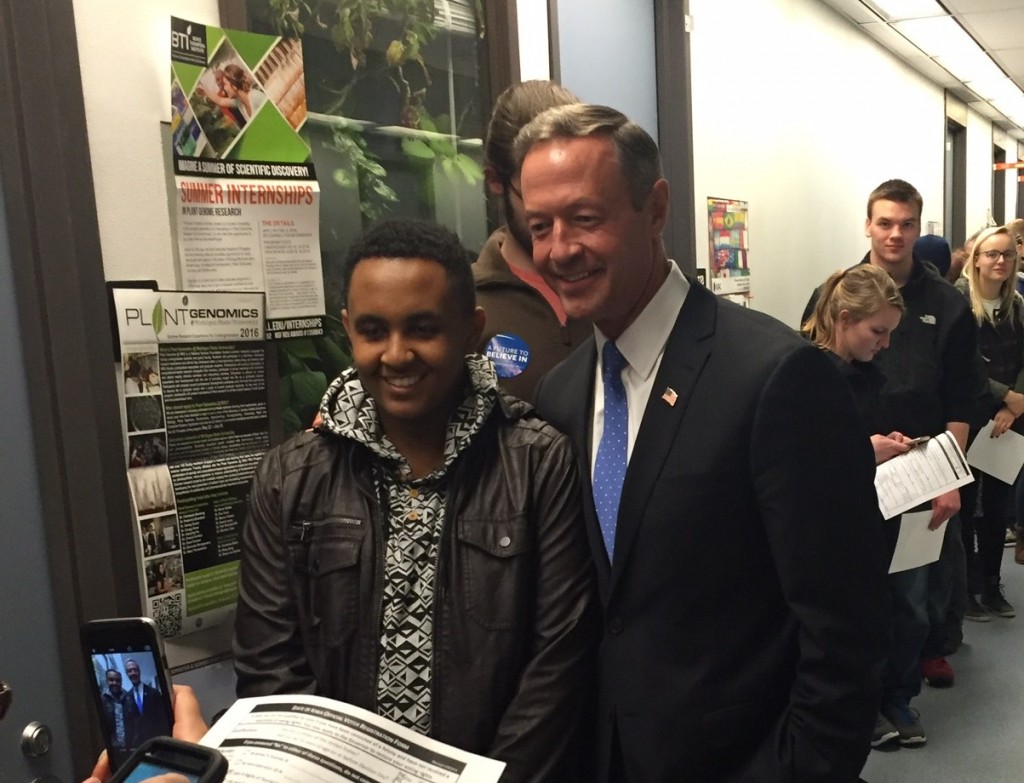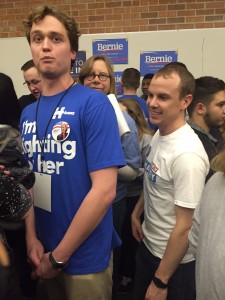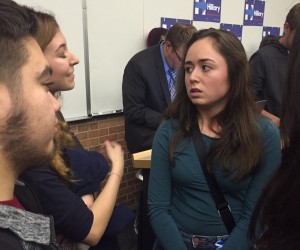
Despite weak support in the rest of Iowa, former Gov. Martin O’Malley had a strong enough showing at the 38th* Precinct caucus, located at Drake University, to reach viability, finishing with more supporters there than Hillary Clinton.

O’Malley himself stopped by the caucus location before the the process began and encouraged those waiting in line to help him reach viability. His supporters succeeded, ending the night with one delegate for O’Malley, while Sen. Bernie Sanders earned three and Clinton earned one.
Brad Hopkins, O’Malley’s 40th Precinct leader, says he was not surprised by O’Malley’s appearance, thanks to a tip from a campaign leader earlier during the day. Hopkins says he also wasn’t shocked by O’Malley’s strong showing at the 40th Precinct.

“One of [O’Malley’s] staff members who was a field organizer in Des Moines is actually a student at Drake,” Hopkins says. “She knew a fair number of the students there personally. So in some ways I think they were there to support her in that sense.” Whatever the reason for the former Maryland governor’s viability at the 40th Precinct, his caucus results were not as strong throughout the rest of the state. O’Malley received a mere .57 percent of the delegates, and officially suspended his campaign after the caucuses.
“The way things were working out in the weeks coming up to the caucus, it wasn’t surprising,” Hopkins says. “I thought he might have stuck around a little bit longer, but that’s where the tide was turning in this race anyway. It’s disappointing because I clearly thought he was going to be the best candidate to unite our country [and] to move progressive agenda forward.”
One of the 113 members in the O’Malley preference group at the 40th precinct was Ali Rumbaugh, a Drake student and undecided voter. During the realignment period, the other preference groups tried to persuade her to caucus for their candidates, she says.
The Sanders and Clinton preference groups didn’t substantiate their claims, Rumbaugh says. She says a conversation with three O’Malley supporters about important campaign issues such as college tuition and climate change convinced her to caucus for O’Malley.
“For example, they talked about how all contenders viewed college tuition these days,” Rumbaugh says. “And they talked about how, while Bernie wants to make all tuition free, O’Malley wants to make tuition debt-free … [O’Malley’s positions] aligned with my values and the way [O’Malley caucusers] supported their facts was very strong as well.”
Rumbaugh says she is disappointed O’Malley dropped out of the race, and says she has a lot of research to do about candidates on both sides of the aisle before the general election.
Courtney Jasper, a steadfast O’Malley supporter and Drake student, says she played a role in Rumbaugh’s realignment to the O’Malley preference group.

Although she caucused for O’Malley, Jasper says she would support any of the Democratic candidates in the general election. Since the attacks in Paris and San Bernardino, California, she says foreign policy has been a key issue in her candidate choice. Jasper says she has shifted her support to Clinton, because the former Secretary of State has more foreign policy experience than Sanders.
“[Sanders] likes to jump back to talking about the top 1 percent [and] talking about climate change, which are also really important, but the fact that he can’t really talk about foreign policy is really disconcerting,” Jasper says.
Before Drake student Russell White attended a political event featuring several candidates, he says he and several of his friends supported Sanders. After hearing O’Malley’s stances on climate change and immigration reform firsthand, however, he says he and his friends became O’Malley supporters. White says he wasn’t surprised O’Malley had more support than Clinton because of the practice caucus at Drake, where O’Malley received four delegates to Clinton’s two.
“I know it’s not the last time we’re seeing him,” White says. “He’ll be back in the future — perhaps when he has more experience under his belt and he can seem like a better package deal for Democrats.”
*Editor’s note: The story originally referred to the Democratic caucus precinct at Drake University as the 40th precinct. It is actually the 38th.

It was actually the 39th precinct.
You’re correct. We had it wrong. We verified it and it was the 38th precinct, not the 40th.